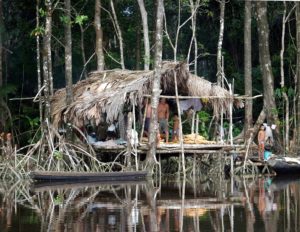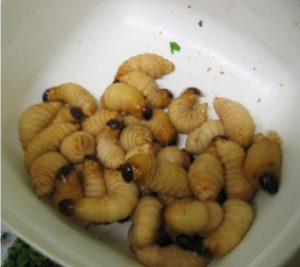There is a well-known saying that goes something like this: “Until lions tell their own stories, tales of the hunt shall always glorify the hunter.” Unlike our knowledge of other nations’ history, little knowledge of the prehistoric story of our first peoples is known or understood among Guyanese, often leading to discrimination and stereotyping.

However, the indefatigable efforts of Jennifer Wishart and others, seek to ensure that Guyana’s indigenous history has its own narrators. Sunday Times Magazine presents the text of “The Prehistoric Warau of Guyana” (1994) by Jennifer E. Wishart
More than 7,000 years ago, when the sea was farther inland than it is today, the Warau lived along the edge of the swamps where the waters of the ocean met with the waters of the rivers.
They ate shellfish which fed off of the roots of the mangrove trees (Rhizophora mangle). Because their diet comprised mainly shellfish, and they lived this way for thousands of years, their refuse heaps, of various sizes, are found along the northwest coast of Guyana. We call these refuse heaps, shell mounds.
The Walter Roth Museum has excavated many of these shell mounds. The artefacts recovered from these excavations tell us how the Warau lived between 7,000 and 4,000 years ago.
Postholes in the refuse tell us that the prehistoric Warau lived in rectangular houses, which were probably thatched with the leaves of the ité palm.
They used beeswax torches for light. The women collected the chewed out honeycombs and boiled them to separate the wax from other unwanted materials. Before the wax cooled, it was formed into lumps, and then pressed into rolls from 30 to 90 centimetres long, and about three to five centimetres thick, like very long candles without wicks.
Strands of ité fibre were wrapped around the rolls and tied, to form external wicks. The wicks were coated with melted wax and the upper end trimmed to complete the abehe, as it is known in the language of the Warau.
The ité palm, also known as the “tree of life”, provided flour for bread. When felled, a large trough was cut into its trunk and the inside pounded with a wedge-shaped pestle to reduce the mush or pulp. This mush was then squeezed to extract the liquid. Recovery of a basketry awl suggests that the aruhuba (matapi) may have been used for this purpose. The liquid was then strained through ite leaves into small containers, maybe calabashes, and left to settle, after which the liquid was poured off to reveal the flour.

The larvae of the Rhyncophorus beetle, mo arani, which lays its eggs in the pith of the fallen trunk, provided fats.
From the nearby brackish-water swamps, the Warau gathered protein in the form of shellfish such as crabs, oysters and the Zebra nerite (Puperita pupa). The nerites were put into calabashes of water, and stones, heated in the fire, were dropped into the calabashes until the nerites were boiled into a soup broth, aho. Animals were hunted with spears and bows and arrows, and fish were caught using line sinkers and cadels.
Women wore bead aprons made from grass seeds, while men wore a loin cloth from the bark of the kakaralli tree (Eschweilera spp.). With a stone bark beater, they beat the bark of the tree until it opened up into thin leaves from which the loin cloth was made. Some Warau today use these leaves to roll cigarettes in times of shortage. Necklaces made from animal teeth were also worn. Body paint, made from annato (Bixa orellana) mixed with oil from the crabwood tree (Carapa guianensis), protected their bodies from insect pests.
When a Warau died, he was wrapped in his ité hammock and placed in his dwelling with his head towards the West – the Land of the Dead. In Warau belief, there is a ‘light’ shaman, bahanarautu, who travels to the House of Smoke in the East, and a ‘dark’ shaman who is in contact with the spirit of the West, hoarautu. Hoarautu feeds on the blood and flesh of human beings.
Around 5,300 years ago, the Warau invented the dugout canoe on Haimarakabra creek, a tributary of the Moruka river. Stone from the Aruka river was taken to Haimarakabra where it was chipped into the desired tool shapes. These blanks were then taken to Warapoko creek where they were ground and sharpened on the boulders there, to form proper tools. These tools were then taken back to Haimarakabra where they were used to shape canoes from the numerous Mora trees (Mora excels), which once grew there.
The dugout canoe was the earliest seaworthy vessel. With its invention, it was possible for the islands of the Caribbean to be peopled. Artifacts found in Cuba date at around 5,000 years ago.
Warau means “tribesman” or “kin”. So Warau living at Waramuri, Warapoko and Warapana may have been related. Fish traps drawn on the rocks at Waraputa Falls on the Essequibo river also appear on the rocks at Warapoko on the Waini river.
Warauan, which is spoken only by the Warau, is the most ancient of the tribal languages of Guyana. Unlike the Arawakan (Arawak, Wapisiana) and Cariban (Carib, Akawaio, Arekuna, Waiwai, Makusi, Patamona) languages, its source cannot be traced and the nearest language to it is Timucua, a now extinct language of Florida, in the United States. (Guyana Times Sunday Magazine)



